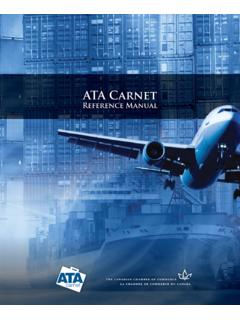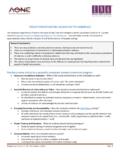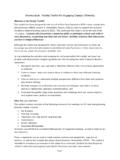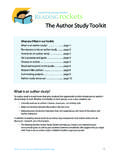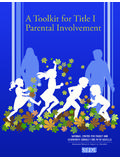Transcription of Anti-Spam Toolkit - Canadian Chamber of Commerce
1 Anti-Spam Toolkit February 2014 Table of Contents Introduction 1 Sending Commercial Electronic Messages 4 Obtaining Consents 12 Message Formalities 15 Updating Messaging Systems 17 Transitional Provisions 18 Malware and Spyware 19 False or Misleading Statements 24 Technical Compliance 26 Working with Third Parties 28 Remedies, Penalties and Rights of Action 29 More Information 32 Appendix A: Initial Compliance Questionnaire 33 Appendix B: CASL Preparedness Checklist 35 Appendix C: Commercial Electronic Message Decision Tree 36 McCarthy T trault LLP 1 Anti-Spam Toolkit Introduction The purpose of this guide is to help organizations navigate Canada s new Anti-Spam law.
2 The Anti-Spam law does not have a formal shorthand name. The official name would take up the space of a long paragraph to print each time. For the sake of brevity, this guide will refer to the law as the Canada s Anti-Spam Legislation , or CASL . This is the term currently being used by government officials and others to refer to the legislation. CASL was passed by Parliament on December 15, 2010 and will begin coming into force in July 2014. CASL will be the toughest Anti-Spam /malware law in the world. In order to ensure compliance, organizations that send commercial electronic messages to Canadians will need to examine the way they electronically communicate with customers, potential customers, other organizations and message recipients.
3 Those who violate CASL could face fines of up to $10 million. Officers and directors can also be held liable if they authorized, acquiesced in or participated in offending conduct. Although many organizations are familiar with the requirements of the US Anti-Spam law, the CAN- spam Act of 2003, the Canadian law is more onerous. In most cases, compliance with the US requirements will not be sufficient for Canadian compliance purposes. CASL s reach extends far beyond what would typically be considered spam emails, potentially applying to what organizations would consider to be ordinary electronic communications.
4 As a result, organizations will need to carefully scrutinize their use of messages sent using email and other electronic messaging systems including SMS as well as of certain messages sent using social networks and online portals. The simple act of sending an electronic message with any degree of commercial content to someone who has not consented to receiving that message can now present significant risks for organizations. CASL prohibits organizations from sending commercial electronic messages unless the recipient has given express consent or the message falls into one of the closed categories where consent is implied.
5 A commercial electronic message is an electronic message that is sent to an electronic address which has as one of its purposes to encourage participation in commercial activity. The term electronic message is defined broadly to include any message sent by any means of telecommunication, including a text, sound, voice or image message. An electronic address is an email account, an SMS account, an instant messaging account or any similar account. CASL also requires that all commercial electronic messages identify the sender, include the sender s contact information, and provide an unsubscribe mechanism so that a recipient can opt out of receiving future communications.
6 CASL amends the Competition Act to prohibit false or misleading representations in the sender description, subject matter field or message field of an electronic message, or in the URL or other locater on a webpage. Senders will have to be particularly wary of making overly boastful statements in subject matter lines in an attempt to catch readers attention. The law also includes amendments to federal privacy legislation ( the Personal Information Protection and Electronic Documents Act or PIPEDA ). These amendments prohibit the use of computer programs known as address harvesters and extends to both the use of address harvesting programs and using electronic addresses that were obtained through the use of such programs.
7 McCarthy T trault LLP 2 CASL creates a private right of action that allows a person to take civil actions against anyone who violates CASL or the new false or misleading representations provisions of the Competition Act. The potential remedies could amount to as much as $1 million per day. The private right of action provisions of CASL will come into force in July 2017. To combat spyware, malware and other malicious software, CASL prohibits the installation of computer programs without the consent of the computer s user or owner. These prohibitions only come into force on January 15, 2015.
8 This guide provides basic guidance for organizations that communicate electronically and wish to address the new requirements in CASL. It includes in Appendix A an initial questionnaire that can help start an internal review process. It also includes in Appendix B a checklist that covers the key points of compliance that organizations will have to consider. The guide also includes in Appendix C a decision tree based on the CASL legislation and regulations. This guide should not be taken as formal legal advice. Note on Regulations and Guidelines: Many of CASL s provisions are impacted by two sets of government regulations; one established by the CRTC and the other by Industry Canada.
9 The CRTC published its final regulations in March 2012. Industry Canada published its final regulations in December References in this guide to CRTC regulations refer to the final CRTC regulations. References in this guide to the IC regulations refer to the final regulations published in December 2013 by Industry Canada. 2 In addition, on October 10, 2012, the CRTC published two Compliance and Enforcement Information Bulletins related to CASL: CRTC 2012-548 Guidelines on the interpretation of the Electronic Commerce Protection Regulations (the General Guideline ) CRTC 2012-549 Guidelines on the use of toggling as a means of obtaining express consent under Canada s Anti-Spam legislation (the Toggling Guideline ) The CRTC regulations prescribe the form of, and content to be included in, CEMs and requests for consent to send CEMs, to alter transmission data in electronic messages, and to install computer programs.
10 The Guidelines focus on the CRTC s interpretation of the CRTC regulations and the related provisions of CASL and provide examples of what the CRTC considers to be compliant Other Important Materials When Industry Canada published the IC regulations, it also published a regulatory impact analysis statement (the RIAS ).4 The RIAS contains somewhat helpful explanations of key aspects of CASL and the regulations. The CRTC also published a short FAQ to help organizations 1 For a summary of the IC regulations see, Barry Sookman, CASL Industry Canada regulations: summary and comments @ and Barry Sookman, The Industry Canada CASL Regulations and RIAS: a Lost Opportunity @ 2 The CRTC regulations can be found @ and the IC regulations can be found @ 3 For a full analysis of the CRTC Guidelines see, Barry Sookman CRTC Issues CASL (Canada s Anti-Spam Law) Guidelines, background and commentary @.

